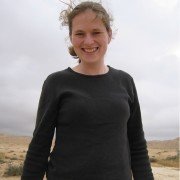Dorothee Huchon grew up in France. Her undergraduate training is in biodiversity, ecology and evolution. In 2000 she received a PhD in molecular phylogeny from the University of Montpellier II (France). From 2001-2003 she carried out postdoctoral research at the Tokyo Institute of Technology and Florida State University. Since October 2003 she is a faculty member of the Zoology department and the curator of the systematic collection of the Steinhardt Museum of Natural History
Prof. Dorothee Huchon

Biography
Research Interests
The research conducted in the lab aims to achieve a better understanding of the evolutionary relationships among animals. Our work concerns animal groups distant from each other, such as rodents, sponges, myxozoans, and tunicates. The dramatic increase in available genomic sequences that are emerging from Next Generation Sequencing (NGS) approaches is revolutionizing the field of phylogeny: while previous species trees were reconstructed based on only a few dozen genes, nowadays, hundreds of genes can be simultaneously analyzed. This shift from phylogeny to phylogenomics necessitates the application of advanced bioinformatics tools in order to efficiently analyze the data.
In our current research, we thus combine NGS and state-of-the-art bioinformatics tools to reconstruct animal evolution. More specifically, our research interests involve:
- Phylogenomics - Reconstructing evolutionary relationships among species based on genome-scale analyses.
- Molecular evolution - Large-scale genomic databases and high throughput sequencing projects combined with experimental approaches now allow us to get insights into genome evolution.
- The use of discreet characters as phylogenetic markers - Sequencing and analyzing genomic retrotransposons (SINES and LINES), and analysis of insertion and deletion characters in protein sequences in order to infer phylogenetic relationships.
- Phylogeography - Understanding sequence variation at the species level, and its correlation with spatial variation.
These research interests are not mutually exclusive and we combine them to study specific animal lineages.
Active research subjects
1.Evolution of Myxozoan genomes (in collaboration with Prof. Arik Diamant, National Center for Mariculture, and Prof. Paulyn Cartwright, The University of Kansas).
With thousands of members, Myxozoa is among the least studied animal group. These parasites have a very simple organization but a complex life cycle that typically alternates between an annelid host and a fish host. Although they are known to cause damage to fish aquaculture, with important economic consequences, very few genes have been sequenced for these species. Using illumina sequencing we aim to improve our understanding of myxozoan genome evolution, and to clarify myxozoan phylogenetic relationships.
2. Tunicate Phylogeny (in collaboration with Dr. Noa Shenkar, Tel-Aviv University, and Prof. Carmela Gissi, University of Bari Aldo Moro).
Tunicates (e.g., sea squirts, salps and larvaceans) form a diverse group of marine animals, either sessile or planktonic. Aplousobranchia is the largest suborder of tunicates. Aplousobranchians are both sessile and colonial. Although aplousobranchians include several armful invasive-species, very little is known about their phylogeny: their family relationships are not resolved and even the number of families forming this suborder is still debated. We aim to sequence complete mitochondrial genomes for representative of the family diversity, in order to resolve relationships within Aplousobranchia.
Recent Publications
Complete publication list available here
- Shenkar N., Koplovitz G., Dray L., Gissi C. & Huchon D. (2016) Back to solitude: solving the phylogenetic position of the Diazonidae using molecular and developmental characters. Molecular Phylogenetics and Evolution. 100:51-56.
- Huchon D., Szitenberg A., Shefer S., Ilan M. & Feldstein T. (2015) Mitochondrial Group I and Group II introns in the sponge orders Agelasida and Axinellida. BMC Evolutionary Biology. 15:278.
- Chang S. E., Neuhof M., Rubinstein N. D., Diamant A., Philippe H., Huchon D. & Cartwright P. (2015) Genomic insights into the evolutionary origin of Myxozoa within Cnidaria. Proceedings of the National Academy of Sciences USA. 112:14912–14917.
- Ashkenazy H., Cohen O., Pupko T. & Huchon D. (2014) Indel reliability in indel-based phylogenetic inference. Genome Biology and Evolution. 6:3199–3209.
- Shpirer E., Chang S., Diamant A., Rubinstein N., Cartwright P. & Huchon D. (2014) Diversity and evolution of myxozoan minicollagens and nematogalectins. BMC Evolutionary Biology. 14:205.
- Rubinstein N. D., Feldstein T., Shenkar N., Botero-Castro F., Griggio F., Mastrotorato F., Delsuc F., Douzery E. J. P., Gissi C. & Huchon D. (2013) Deep sequencing of mixed total DNA without barcodes allows efficient assembly of highly plastic ascidian mitochondrial genomes. Genome Biology and Evolution. 5:1185–1199.
- Churakov G., Sadasivuni M.K., Rosenbloom K., Huchon D., Brosius J. & Schmitz J. (2010) Rodent evolution: back to the root. Molecular Biology and Evolution. 27:1315-1326.
- Belinky F., Cohen O. & Huchon D. (2010) Large-scale parsimony analysis of metazoan indels in protein-coding genes. Molecular Biology and Evolution. 27:441–451.
- Blanga-Kanfi S., Miranda H., Penn O., Pupko T., DeBry R.W. & Huchon D. (2009) Rodent phylogeny revised: analysis of six nuclear genes from all major rodent clades. BMC Evolutionary Biology. 9:71.
- Huchon D., Chevret P., Jordan U., Kilpatrick W. C., Ranwez V., Jenkins P. D., Brosius J. & Schmitz J. (2007) Multiple molecular evidences for a living mammalian fossil. Proceedings of the National Academy of Sciences USA. 104:7495–7499.


